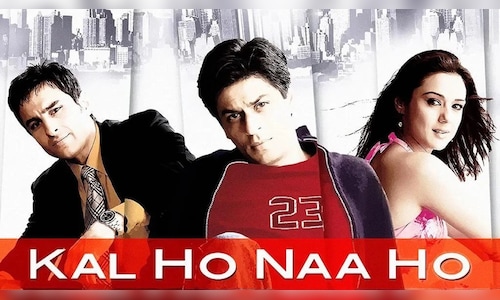

If you’re even semi-active on social media, you must have seen at least one video of an audience going berserk in a theatre, dancing to Maahi Ve from Kal Ho Naa Ho, turning their movie-watching experience into a carnival.
Nikkhil Advani’s 2003 romantic-drama re-released in November on the occasion of it clocking 21 years. Starring Shah Rukh Khan, Preity Zinta, and Saif Ali Khan in lead roles, it has raked in an impressive ₹5.45 crore at the domestic box office in 17 days. This, when the film is available for streaming both on Netflix and Prime Video.
Our worlds have altered drastically in the two decades since Kal Ho Naa Ho’s initial release and yet, the film continues to speak to cinephiles in a way few movies from the turn of the century can anymore. Several factors are responsible for Kal Ho Naa Ho’s enduring popularity, each fortifying its indispensable place in the contemporary cultural zeitgeist.
I have to start with its timeless music. In spite of their consistent, almost stubborn prolificacy, Kal Ho Naa Ho continues to be one of Shankar-Ehsaan-Loy’s best albums to date. No house party is complete without It’s the Time to Disco, no wedding sangeet without a full-family banger Maahi Ve performance. If someone listens to Kuch To Hua Hai more than they should, it is reason enough to barrage them with questions. Kal Ho Naa Ho’s songs are not just music, they’re a language, a way of life.
The film has stood the test of time also because it belongs to the NRI bracket of Dharma-YRF movies that the two production giants shifted their focus onto towards the dawn of the new millennium. Bolstered by the wild, dizzying success of Dilwale Dulhania Le Jayenge (1995) and aware of the Indian diaspora exploding around the world, they began making “cool” films on Indians living abroad. Telling their stories also powered them with the agency to touch upon issues hitherto considered off-limits.
Kal Ho Naa Ho was one of the early experiments. Its protagonist, Naina Katherine Kapur (Preity Zinta), is the daughter of a Sikh man and a Christian woman in New York who goes on to marry a Gujarati friend. Her fractured family dynamic—father who killed himself, physically disabled brother, adopted younger sister—and the resultant unhappiness is the film’s foundation. With estimated global earnings of ₹82.9 crore, it was the second-highest-grossing Hindi film of 2003 after Rakesh Roshan’s Koi Mil Gaya.
The film’s box-office triumph reconfirmed movie moguls Karan Johar and Aditya Chopra’s foresight. A template was born. A slew of similarly coolly packaged films followed. They all had megastars, chart-bursting music albums, were set in plush international locations, and dealt with thorny themes. If you look closely, like Kal Ho Naa Ho, Hum Tum (2004), Salaam Namaste (2005), Kabhi Alvida Naa Kehna (2006), and My Name is Khan (2010) have all aged well because their central conflicts—be it unwed pregnancy, adultery, sexual incompatibility, or islamophobia—are timeless.
Finally, the key reason behind Kal Ho Naa Ho’s popularity then and now—Shah Rukh Khan. With story and screenplay by Karan Johar, the film worked then because Khan was at the zenith of his blistering career. If you revisit the film, you’ll find Saif Ali Khan and Preity Zinta’s performances less laboured and more watchable, but people are thronging the theatres all these years later for the man they grew up loving.
Kal Ho Naa Ho works today because their hero has become a recluse who, in the age of mind-numbing overexposure, has been able to retain a sense of mystery, leaving his devotees in a perpetual state of want. It’s been a year since Dunki, but SRK hasn’t announced his next acting project yet. In uncertain times like these, when the audience doesn’t know when they will get to see him on the big screen next, you can count on them to lap up any chance they get to experience his magic.



